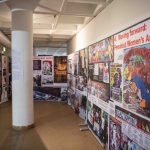Museums’ monumental shift from past to present
Collected objects and artworks, and the museums in which they’re held, offer clues to history and heritage. But their meanings and values are shifting to tell the evolving stories of us.
Author:
15 October 2019

Inside a vitrine is a scrap of paper, one edge an untidy tear where it’s been freed from the coils of ring-binding. It’s ordinary and everyday. What’s written on it, though, isn’t.
The writing is a neat script, but with unusually angled letters in places. The sentence begins with two asterisks and, in parts, words have been scratched out and alternate edits added. It’s Nelson Mandela’s handwriting and it’s the speech he prepared as the Rivonia Trial wrapped up proceedings in the mid-autumn of 1964. It would consign him to a life behind bars for conspiring to overthrow the state.
Today, this piece of Mandela’s writing is known as the famous “I am prepared to die” speech, about the ideals Mandela would have paid for with his life. This scrap of paper is one of the objects, artefacts and ephemera that make up the massive collections belonging to the University of the Witwatersrand. It is part of Wits’ Historical Papers research archive at the university’s William Cullen Library and was on temporary loan to the Wits Art Museum (WAM) for its Wits90 Treasures exhibition in 2012, when the university turned 90.
Related article:
The WAM’s collection contains about 15 000 artworks. They include Walter Battiss’ Fook Island bank notes and waste bags, and the repatriated collection of 300 of Gerard Sekoto’s drawings and sketches. The Sowetan newspaper bought the Sekoto collection so it could be returned to South African soil from Paris, France, where the artist, considered a pioneer of black African art, died in self-imposed exile in 1993. This collection has been housed at Wits University since 1989 and was formally donated to the WAM in 2010.
There are also hut tax tokens in the collection. Hut tax introduced by British colonialists in Africa would be one of the dark genesis moments that would disrupt a way of life forever and start South Africa’s troubled and enduring legacy of forced economic migration.
Items like these hold value not only by being pieces of history but also as clues to heritage and the layered stories of South Africa and “South Africaness”. These objects and pieces come to have contemporary relevance when they’re displayed with the intention to spark conversations and have a deep impact.
Redefining museums
“Explode conversation,” is how Leigh Leyde, the WAM’s education curator, puts it. “Art and museum spaces allow you to have conversations that you can’t have around the dinner table.” The museum experience should be challenging, confrontational even, because the idea of heritage, especially collective heritage, is not straightforward.
“Whose heritage? Who is ‘us’? Who gets to tell their stories? Who are we speaking to?” she asks of the questions that fan out further and further the more you ask them. “For me, objects carry stories and humanity, because art is made by hands. It migrates through hands and accumulates more stories as it’s passed on.”
The questions are the point, really, forcing museums to rethink their roles and relevance. In a recent Time magazine article, Suyin Haynes reported on a controversial vote at the International Council of Museums (ICOM) – a United Nations-style body for museums that represents 119 countries, including South Africa – to redefine the meaning of “museum”. It says the vote is “an attempt to outline exactly what a contribution to broader society could look like for museums today”.
Related article:
The ICOM’s proposed new definition describes museums as “democratising, inclusive and polyphonic spaces for critical dialogue about the pasts and the futures”, with a goal of contributing to “human dignity and social justice, global equality and planetary wellbeing”.
The vote, which is expected to go to a second round, has divided opinion. Some welcome the new definition of museums as institutions that reflect society’s shifting priorities, others say the new definitions are too political, ideological and fly in the face of the traditional functions of museums.
“Museums can’t be dead spaces,” says WAM senior curator Julia Charlton. She adds that a visual arts museum like the WAM straddles its custodianship of collections for future generations, its role as an education and training museum, and being a public asset.
Access and inclusivity
“Public” for Charlton means access and inclusivity. It’s everything from the location of the museum at the edge of the university’s campus towards the heart of Braamfontein and its architecture, its free admission and free access to programmes, and its diversity of programmes, exhibitions and events. It is about the consideration that has gone into the text on the walls, which is not drowned in jargon, and about using artwork to promote interdisciplinary learning.
The WAM also shares its resources with other universities and institutions, and collaborates to create shared teaching programmes.
The museum takes part in events such as First Thursday and the inaugural Museum Night in Johannesburg on Thursday 19 September. These initiatives challenge how people use their downtime during a working day and perceptions about the city at night. Generally, it’s about loosening up a little more, making a bit more room for different voices and different approaches.
Aha moments
When visitors to the museum have an aha moment, it’s gold for Charlton. She recounts two past experiences.
One was a school event centred on the museum’s exhibition, Umhlaba 1913-2013: Commemorating the 1913 Land Act. Each child was given a coloured sticker on entry and asked to stand in a matching coloured circle drawn on the museum floor. As the one circle got increasingly squashed and cramped, one child cried out: “It’s not fair.” “They just got it at that point,” says Charlton.
The second incident was at the 2014 launch of an exhibition by photographer and activist Zanele Muholi, titled Queer and Trans Art-iculations: Collaborative Art for Social Change. As the first speeches were about to be made to the 700-odd people packed into the museum that evening, the people Muholi had photographed erupted into spontaneous chants of “We are democracy in action, we are democracy in action”.
“That was a chant that we were a safe space for people in the LGBTQIA+ community, who claimed the museum space and exhibition decisively and publicly,” says Charlton.
Changing perspectives
WAM curator for strategy, planning and development Lesley Cohen has seen people change their perspectives, gain a little empathy for others and themselves, or simply find a moment of quiet by visiting the museum in between appointments.
“A class may come in here from engineering or from medical school, and the students may be asked to look at artworks and to discuss what they see. They learn that there are no wrong or right answers, just different perspectives.
“With something like the exhibition of works by Albert Adams, who was born to Indian and mixed-race parents, people started talking about difficult topics like slavery,” says Cohen.
Related article:
She says museums should have multiple access points and be non-prescriptive. The WAM has hosted mindfulness workshops, yoga workshops and offered drop-in drawing sessions or art-making events linked to their exhibitions.
“It’s a little pyramid. Right at the bottom are the many people looking through our glass walls as they make their way through the city. At the next level, maybe, are people who’ve come to a yoga workshop and decide to come back to look and see more of an exhibition. Further up the pyramid are school groups and people who come on walkabouts, and closer to the top are those who use the collections for in-depth research.”
A museum with 15 000 items cannot be all things to all people all of the time, but the WAM’s intention is to keep trying.
As Leyde says: “When people leave an exhibition with more questions than they started with, then I feel we’ve done our jobs. It’s about showing the material culture we’ve collected in an environment that invites someone to look deeper and to ask different questions, even of the museum.”



